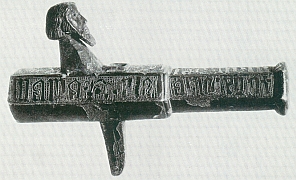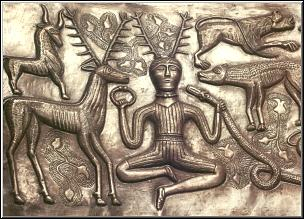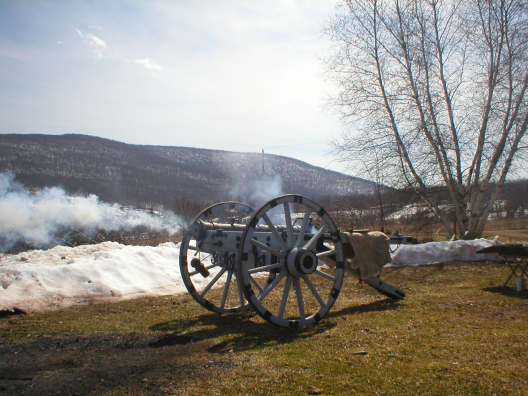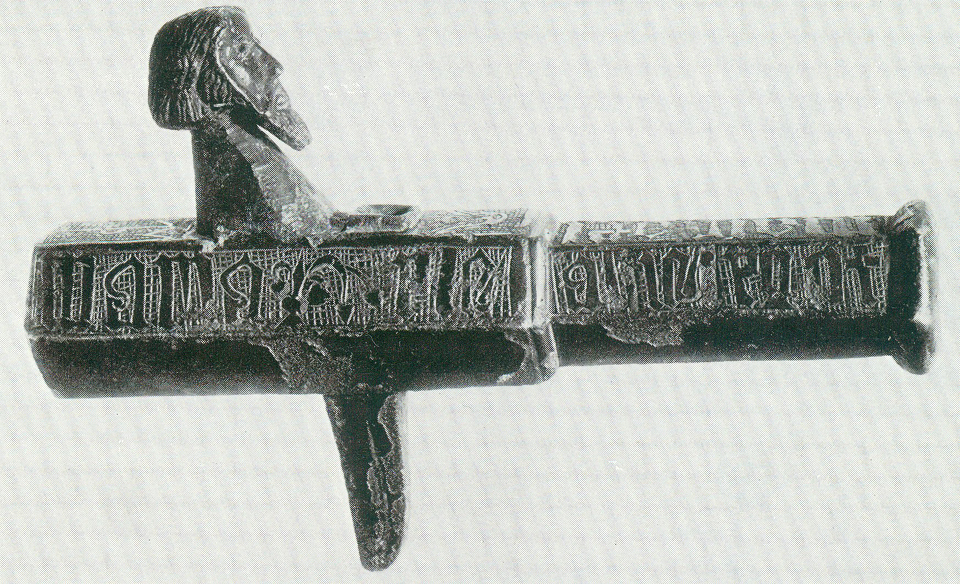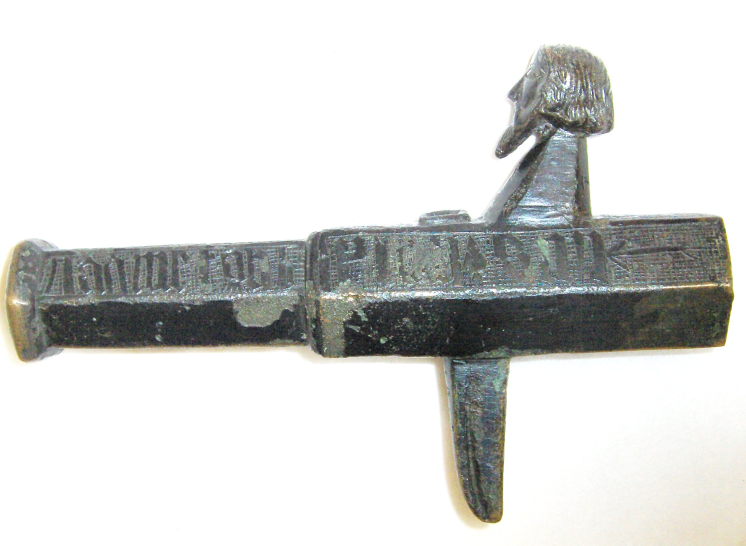I WANT YOU TO FIND “AVE MARIA” IN THESE IMAGES FOR US. SEE! YOU CANNOT; BECAUSE IT IS NOT PRESENT. NOW TRY WEARING
ROSE COLOURED GLASSES. THAT IS WHAT THOSE WHO SEE IT ARE WEARING.
|

THIS IS THE REMAINING PANEL. “AVE MARIA”; GO FIND IT. THAT IS NOT “MARIA”, NOR IS IT AN AD FOR MAINE POTATOES OR
OVALTINE.
First of all, allow me to explain that the language embodied on Morko, is NOT Latin. Here is the popular invocation to
Miriam/Maria/Mary, the legendary mother of Jesus of Nazareth. It is in Latin, the language of the Church of Rome. To some
of you, it may not be familiar.
Ave Maria, gratia plena, Domus tecum. Benedicta tu in mulieribus, et benedictus fructus ventris tui, Iesus. Sancta Maria,
Mater Dei, ora pro nobis peccatoribus, nunc, et in hora mortis nostrae, Amen
Hail Mary, full of grace, the Lord is with thee. Blessed art thou amongst women, and blessed is the fruit of thy womb,
Jesus. Holy Mary, Mother of God, pray for us sinners, now, and at the hour of our death, Amen.
Here is the “Lord’s Prayer” in Anglo-Saxon (a.k.a. Old English). Do not make the mistake of believing that the language of
Old English is the sole property of the island people of Britain. It should actually be called Angleish because it is the
language of the Anglo-Saxons. It is a West Germanic language closely related to Old Fresian and heavily influenced by Old
Norse. It was the language for a considerable part of northern Europe.
Thu ure father, the eart on heofonum, sy thin nama gehalgod. Cume thin rice, sy thin wylla on eorthan swaswa on
heofonum. Syle us todaeg urne daegwamlican hlaf. And forgyf us ur gyltas swaswa we forgyfath thampe with us agyltath And
ne lae thu na us on cost nunge, ac alys fram yfele.
n.b. The type face I am using, is not “Gothic” and it causes a problem with comparisons.
I typed “nama” in bold because it appears twice on Morko. I believe that the mistaken observer-commenters are
identifying this as “maria”. It actually translates as, “NAME”.
On Morko, to the untrained eye, it appears to be mama. If you look closely, it is written as inama. That is an abbreviation
for in nama. They were working with limited space on a small panel. It actually translates into English as, “IN NAME” or
“IN THE NAME”.
If you consider the words and composition of The Lord’s Prayer without a bigoted eye, they could easily represent an
invocation to Odin. It fits! Odin was a Father in Heaven too. There is very little, if anything, that is original in the
world of religion. That was why conversion was often simple enough. Only the names were changed.
Morko has been given the date of ca. 1390. It’s a safe enough middle of the road bet. Simple handguns appeared ca. 1330s
with known bronze examples dating ca. 1350. They continued into the 15thc., ca. 1460s. That gives us 150 (±) years to play
with language.
|
Let us clear up the MARIA/MAMA/NAMA/INAMA/IN NAMA issue. It is a simple matter of knowing a few of the
rules for the scribing of medieval black letter script (a.k.a. minuscule, Gothic and Old English). The following
rules are employed to conserve space.
Biting The Bow: If a letter ends in a perpendicular and the following letter begins with a perpendicular, one of
the perpendiculars can be eliminated; giving you a half letter, joined to a complete letter.
Suspension: Omission of letters at the end of a word or only writing the word’s first letter.
Contraction: Omission of one or more letters in the middle of a word.
I remember an article in the New York Times, Science section a number of years ago. A scientific study
(wasting a lot of money) pointed out what we already knew, e.g., we can read words that have a number of
letters omitted as in, “I plege alegince t th flg”. Any medieval scribe without the benefit of a PhD, was
already doing that very thing.
Any literate person looking at the Morko during that time frame, knew what was actually written. Most
importantly, the commissioner of Morko, knew full well what he wanted Morko to say. Morko was his
statement. What was important to him, was placed on Morko. Morko was his mojo.
As for the language on Morko, this 150 year period saw the use of Rune, Old Norse, Old English, Anglo Saxon,
Old Swedish, etc., all in the area of the Baltic Sea; besides Middle English that developed after the Norman
invasion of Britain in 1066. I have excluded Latin because it is as relevant to Morko as is Chinese.
I researched the territorial use of the word “name”. Old English; nama. Anglo-Saxon; nama. Old Fresian;
nona. Middle Fresian; namme. Old Swedish; namn (?). Middle English; nam/naim/naime/nome. Middle English
is based in Old English (Anglo-Saxon) with a French influence. Anglo-Saxon (Old English) continued to be
used elsewhere. I believe Morko is Anglo-Saxon. in nama pia becomes inama pi. I’ll translate it for you later.
The outstanding bust on Morko is that of Odin; not Jesus. Christianity was introduced to Scandinavia many
centuries before but not everyone subscribed to it. Subscriptions also ran out in many cases. Here is a more
contemporary image of Odin . Compare it to Morko’s.
|

Odin the Wanderer circa 1886 by Von Rosen

Medieval image of Woden/Odin.
The manuscript was drafted to record Henry II direct
descent from Woden. This was a common claim made by kings in medieval times.
Odin is the Scandinavian name for the god called by the Anglo-Saxons “Woden”, the supreme god of the
later Scandinavian pantheon, he having supplanted Thor. Odin was the “the High one”, “the All-Father”,
god of wisdom, poetry, magic, war and agriculture. His two black ravens, Huginn (Thought) and Muninn
(Memory), flew forth daily to gather tidings of what was being done throughout the world. One of his names
is “Ygg”, associated with the World Tree (Yggdrasil) in whose branches his ravens dwell. He is closely
connected with a horse and a spear. His three wives were earth goddesses and his eldest son was Thor, the
god of Thunder. Wednesday is Woden’s day.
Thor is the strongest of the chief gods, whom he helped to protect from their enemies, the giants. He had a
magic hammer. Thunder was the sound of his rolling chariot. Thursday is Thor’s day.
Tyr/Tiwaz is the one armed god of battle, justice and the warrior. He is a son of Odin by a giantess. Tuesday
is Tyr’s day.
Loki is the god of strife and spirit of evil; the father of the Serpent Fenris and Hel the queen of the dead. She
dwelt beneath the roots of Yggdrasil, the sacred ash tree. Loki is like the mythological Satan or devil. He is
associated with fire. “GO TO HEL!”.
Rune is the Norse alphabet & writing system that uses stick figures. Some rune had more than one meaning.
Runes could also be combined with one another to build a meaningful expression . The provided chart,
illustrates some of the many rune and only some of their meanings. Morko sports a number of rune figures
that are easily interpreted. Rune were used as “charms” on weapons. Certain arrangements allowed a person
to wield sorcery.
Yggdrasil is the World Tree, an Ash, the Tree of Life. It is identified with Odin. One of his names is Ygg. In its
branches, roost the Ravens; Odin’s totem. In its roots, lives the Serpent. The death of the world will occur
when the wolf Fenirir and his pack roam the world, spreading death. Yggdrasil, rises to heaven and upon its
branches all things rest. It will be shaken and the gods will perish and a new race will inherit the earth. (Adam
and Eve fable?)
Bo or Boh is a son of Odin and a fierce Gothic Captain. When Vikings attacked and surprised an enemy, they
invoked his name and shouted, “BOO!”.
|
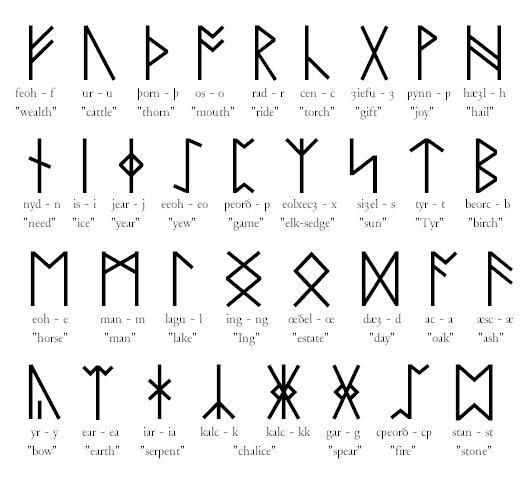
An incomplete set of Anglo-Saxon rune.

Rune found to the rear of the Morko bust of Odin. It is an amalgam of two rune. The W mounted on its
own perpendicular, represents EA and the crescent inclusion is normally on a perpendicular of its own
and is in itself the TH sound.
Besides these meanings, the EA represents EARTH and GIANT. While the P
besides the TH sound, is PORN, pronounced THORN and represents THOR as
a GIANT.
These are Anglo-Saxon rune.
|
The rune that resembles an arrow, is also a combination of two rune. The ARROWHEAD with its own “shaft”,
represents the god TYR, TIWAS, the WARRIOR, GOD OF JUSTICE, GOD OF WAR, VICTORY IN BATTLE.
The SHAFT figure with the splayed feather-like end is significant for its use in place of the word
“PROTECTION“. It can be invoked as a magic charm of sorcery.
Placed together they represent PROTECTION FOR THE WARRIOR. Morko’s owner.
|

Found on the butt end of the left side
|
These are Anglo-Saxon rune.
|
Next to decipher, is the mark near the touch-hole. A very appropriate artistic application.
|

It will have to be cleaned up, to see the actual image because it is crudely done. A clue is the fact that sulphur
(brimstone), fire and smoke are associated with the cup above it, where the priming powder is received and
the charge is touched-off to discharge a deadly missile.
Crude art work.
|

The 14th century medieval Pope |
|

the Morko image after cleaning |

A photo by Sven Rosborn, Malmo Sweden. This figure was painted in 1323,
on the church of Sodra Rada, Varmland, Sweden. It has since been destroyed.
Google it. Mr.Rosborn has a fantastic website. He is the Scientific Leader of the
Museum of Foteviken in Sweden. Pay him a visit on the web or at the museum.
|
There are other cartoons on Morko that pertain to Odin and Yggdrasil.
|

This is representative of Odin asYggdrasil. Pictured is a spray of fronds.
Crude art work.
|

The Tree of Life as independent art work. |
|

Hedging all bets.
A cross, Yggdrasil & Odin’s Ravens. |
When the Tree of life is shaken, all will fall and there will be a new world order. I am mindful of the Serpent that
makes his home in the roots of the World Tree. This appears to be another possible borrowed theme of the
New Religion, e.g. Adam & Eve with the Serpent. The idealic world was shaken, collapsed and the new order
begun. Another easy conversion fable. Morko was a very heavy statement. I wonder what the owner was
into?
|
| | | |
| More crude art work. It doesn’t surprise me that many of the letters are also malformed. |

Morko’s Right Side Panel Cartoon
|
|

Left Side Cartoon |
Notice that the center spear-like perpendicular in the panel‘s representation of the World Tree, Tree of Life, World
Ash, that is here on the left also resembles the spear-like form of the panel’s cartoon on the right. The one on the right
is stripped of its foliage, as if it has been “shaken”. I separated the image from the verbage to clearly illustrate my
statement. Is this prophetic? I wouldn’t want to be near the Morko’s owner if he had been into the mead.
The only other markings worthy of comment, other than the script itself, are these marks. They appear to be random
scratches, concentrated at a single blank area, as if the fisherman after removing Morko from his net, scratched it to see
if it was perhaps gold. Look directly under the head. The image was enhanced by “Eagle-Eye” Andy (gulfcoastblackpowder).
|
 |
|
 |
| This is the only panel that I feel I have had a measure of success with. Parts of it are repeated on
other panels. It calls into play the rules for the medieval scribe to work with. Biting the Bow, Suspension and
Contraction. All three create problems with deciphering |
 |
The first figure may appear to be an [m] but I do not believe that it is an [m].
Three characters to the right is what I believe to be an [m].
Notice that the center perpendicular has a pointed base.
This isn’t a slip of the tool because it is repeated elsewhere on Morko.
The first perpendicular is not connected to the next perpendicular and it is footed.
It is the letter [I].
It is followed by a letter [n] as it should be because it is the word [in].
Now a rule comes into play.
The word following [in], is [nama] (name).
However the letter dropping rule comes into play when an [n] is being followed by an [n].
An [n] can be eliminated and the two words will be read as, inama, instead of in nama
Next comes the symbol for Yggdrasil which doubles for the name ODIN.
Next letter is [P].
Then the letter [I].
What is missing is the following letter (scribe’s rule) which should be an [a].
The last figure is a puzzle. It appears three times on Morko’s panels. Great for a tattoo. |
 The engraver wasn’t going to include
something that was meaningless. It had to have meaning to the comissioner. After all, letters were being dropt to
save space. Kapish? The engraver wasn’t going to include
something that was meaningless. It had to have meaning to the comissioner. After all, letters were being dropt to
save space. Kapish?
|
| This is as it is on Morko. Allow me to interpret the meaning for you as I see it. |
| inama |
 |
pi |
 |
in nama (ODIN) pia (?)
NAMA is “name” but it is also:
A title of rank or dignity.
A categorizing name.
A name appellation.
Reputation
Fame.
Understood to be, “The devine name what is told“.
PIA is “gracious”.
Used conventionally during the 14th c. as godly, merciful, compassionate of royalty and high nobility.
I carry this, “In the devine Name what is told (understood to be Odin) the Godly and compassionate.
Christianity, the new Oriental religious faith, had been introduced to the Baltic area about 500 years before Morko was
cast. In the middle of the Morko time frame of 150 years, The Polish-Lithuanian Commonwealth with its allies, who were
mostly Roman Catholic, came to the defense of Lithuania; one of the last Elder Faith bastions in Europe. They went against
the Teutonic Order, whom The Pope sided with and encouraged in their lawlessness. They defeated the Teutonic Order with the
Battle of Grunwald-Tannenburg in 1410. My ancestors left Moravia as mercenary cavalry with Jan of Jicin at that time, in
support of the largely “pagan‘ Lithuanians. As victors, they were given land grants in the Grand Dutchy of Litva, where my
family resides to this day. The rune they carried to Grunwald-Tannenberg is important to me. It is the Polish banner of the
Odrowaz clan and in rune, represents horse warriors and Jicin in Moravia. The Oder (Odro) River was a Norse thoroughfare
(hence the rune). Lithuania was Baltic, across from Sweden . Was Morko at the battle of Grunwald-Tannenburg; the first major
battle with artillery?
My cannon is of Bohemian/ Moravian design, which found extensive service during the early 15th century Hussite Wars. The
Hussites were deemed to be heretics. I replicated it myself with a blacksmith friend on his forge.
The opinions stated herein, are mine and as it seems from the lack of any original cyber analysis; mine alone. The letters
and words are nearly impossible to read, with the language being foreign, dead and generally difficult. GOFUHVIT! Be my
guest.
RRC
|

An image of me, courtesy of Victor3, with BoomJ holding his crucifix (and his head). |

Right side breech panel
In my opinion I have already successfully translated it earlier in this paper.
|

Top side muzzle panel
The above two images basically carry identical inscriptions relative to lettering.
|

Right side muzzle panel
Unusual letter, third from right, observe the base. See that strange symbol again?
|

Left side muzzle panel
Quite a few unusual letters. I cannot find them in any book.
|

Left side breech:
3rd from left, ? mystery symbol. Right letter, pointed like M but not an M.
|
Was Morko dropt overboard?
Did a ship or boat sink?
Because of bad weather?
Was there a battle?
Was the owner going to or returning from a campaign?
Was Morko war booty?
How many were in possession of Morko before it was lost?
Who was the original owner?
Where was it made?
Why is the engraving less than second rate when good craftsmen were available?
Was it made in the Middle East by someone unfamiliar with the alphabet?
If it had a wooden stock, why didn’t it float and drift onto a shore?
What else came up in the net with Morko?
Was it charged when it was recovered?
What was recorded in 1828?
What has been recorded since 1828?
We will never know any of the answers to these questions and I seriously doubt anymore translation can effectively be
accomplished but we now know more than we did yesterday.
Will what I have done, make any difference?
I seen me duty and I done it.
Now I can sit by my fire and cogitate.
|
 RRC RRC
|
Morko Man Revealed
A LOGICAL EXPLANATION
July 2014
| The Morko handgonne is embellished with Gothic script, cartoons and a cryptic cartouche. This cartouche appears three times within the three embossed sides of the piece. It is clearly not an example of script and it is not a cartoon per se. Over the course of one thousand years, much of what is being said on Morko is indeterminable upon first encounter but it can be readily explained with the aid of a computer if one is not intransigent.
|
| |
| The cartouche remained a challenge for me until recently. At first glance, I had identified it as a modified rune (roon, not roo-en ), i.e., the two thousand year old Nordic script that was affected by numerous cultures, albeit with slight adjustments. The heart of it resembled the Elder Futhark rune for the letter "U". Here is a common rune chart. |

| Over the span of a thousand years, the letter U continually evolved but it was still quite recognizable. |

| If it walks like a duck and it quacks like a duck and it looks like a rune, it must be a rune. |
| |
| What threw me off, was that it was quacking, when it should have been mooing. The U represents a bovine, i.e, a Urochs/Aurochs. I should have known better: I raised polled Herefords until recently. |
| |
| More about the "mooing" in a few moments, or should that be, mooments? |
| |
| Why would a man alter a perfectly good rune and plop it on a handgonne that was a masterpiece? |
| |
| It was done because he was a man of the hour; a man in step with the times. Runes were being modified for a thousand years. They were a recognizable link with the past and a medium that could still be read by the uneducated. Even Kings did not always know how to read. This cartouche was in essence, a logo, a signature. We still identify logos and know where to get a burger without reading words. This modified rune identified the owner. It was a simpler means for identification without his written name. |
| |
| I cannot imagine anyone inscribing STUZYNSKI or APANOWICZ on a war shield or even a short name like ROWNY, to identify themselves during a melee. Here we see my families' devices as they developed from simple rune to more elaborate presentations that could still be easily read. The rune was still central to the artistic device. Morko Man did the same thing. |

DURING THE TRANSITION PERIOD, THE MIDDLE ONE CONVERTED TO CHRISTIANITY
| Medieval masons and carpenters, used marks to identify their work in order to receive their payment. Modern Royal Arch Freemasons still choose a "mark" to identify themselves. |
| |
| I always inscribed an identifying mark into the furniture and decoys I crafted, rather than sign my name. The piece that I did for GWB which is in the White House permanent collection, and curated by the Smithsonian Institution, only has my mark and not my name. |
| |
| Medieval Europeans used what are called house brands and house marks to identify personal property, often to replace a signature. The Dutch referred to them as "huismerks" and "handmerks." They often derive from rune. Here is the example from a Dutch gentleman, who was still using a mark to sign documents in 1648. |
Dutchman's mark The rune for the letter S.

| So! What was Morko Man saying about himself? He certainly conveyed his beliefs, his faith, his loyalty on his handgonne but what and how did he feel about himself? His signature, a.k.a. his sign, is a rune and is quite mooving once you realize exactly what it represents. One can feel the power of the man in his choice of rune.
|
| |
| The "U" rune, represents Ur, Uruz and Urz. The meaning of which is UROCHS (old), AUROCHS (new). It is the prehistoric, magnificent, massive and venerated bovine, found in Cro-Magnon cave art paintings and bone carvings throughout a large portion of Europe. |
| |
| Morko Man took the Futhark Rune which represented the Urochs and had the horns artfully combined with the rune by placing the right horn as an extension on the final up sweep of the rune and nestled the left horn in the hollow formed by the sweep. The mystery symbol now becomes obvious. |

cave painting

| The Urochs weighed over a ton and stood over 6 feet at the shoulder. It was the size of a small bus. It dwarfed the present day matador's bull. |
matador with bulls

| Having seen a Urochs, Julius Caesar noted, "They are swift and fast, very aggressive and dangerous. They are not concerned when man approaches". An accurate description of our Morko Man? |
| |
Old English Poem:
n Ur byp anmod ond oferhyrned fela frecne deor, feohtep mid hornum maere morstapa, paet is modig wuht. |
| |
In Modern English:
The Urochs is proud and has great horns; it is a very savage beast and fights with its horns; a great ranger of the moors, it is a creature of mettle. |
| |
| By the 13th century, Urochs only existed in small numbers in Eastern Europe. The hunting of Urochs had become a privilege of nobles and in later years, only royal households. Poaching was punishable by death. Their range was restricted to Poland, Lithuania, Moldavia, Transylvania and East Prussia. By 1564 there were only 38 remaining in Europe where they were carefully managed by Foresters. |
| |
| The last Urochs (a cow) died in 1627 in the Jaktorow Forest of Poland. Presently in Poland, there are scientists working with DNA extracted from museum mounted specimens. Their goal is to bring the noble beast back from extinction. |
| |
| I will say this; the area for Morko Man's living space has been narrowed considerably by the preceding paragraphs. I would look to the area of Europe that contacts the Baltic Sea; to those lands that were home to Urochs. |
| |
| Morko Man knew and used rune. He knew and used Gothic script. He knew and honored the pre Christian Elder Faith. He was familiar enough with the Urochs to adapt them to fit his alter ego. He could well afford to commission the casting and finishing of Morko. Poland and Lithuania are good bets for his home land. |
| |
| The battle of Tannenburg was fought in 1410 with the Polish-Lithuanian Commonwealth against the Prussian/German Teutonic Order. The Teutonic Order was ruthlessly suppressing the Lithuanians who clung to their Elder Faith. This was the age of Morko and fertile ground for Morko Man. Poland's interest in handgonnes dates to the late 14th century with cast bronze, multifaceted hooked barrels. They were used in large numbers against the Teutonic Knights at Tannenberg.1 |
| |
| A final thought (or two.) Since Morko had a wooden stock, I wonder and doubt if its odyssey was limited to the water in Sweden. It could have floated on the Baltic with the winds and currents propelling it for who knows how long before the stock separated from the handgonne, allowing it to sink? A century? More? Consider how long bottles with messages in them are floating around before they are found. |
| |
| Thought number two: Was it tossed religiously into the water as an offering? Weapons were often ritually deposited in water spots by believers. Morko Man was, by all indications, a believer. |

THE END
of a believer?
11th century illustration. Notice the Rune U noose.
Addenda
| This ADDENDA is here because I don't walk in shoes with laces untied. "The game ain't over 'till it's over."--Yogi Berra. This addenda is a Gordian Knot, tied with threads from the Morko handgonne, Urochs, Teutonic Order, the Elder Faith, rune, Poland and Lithuania. It may fill in some blanks you might have, since I noticed some things that might be questioned. |
| |
| The extinction of the Urochs in the Baltic areas of Poland, Lithuania and east Prussia, was prompted by the arrival of the Teutonic Order. Their culinary tastes required reliance upon beef and animals in general. Within the first few centuries of their arrival, there were major cultural and ecological changes. They brought with them the practices of land clearing, castle and estate building, town expansion and extensive hunting. The Urochs habitat and its on-hoof population were negatively influenced. |
| |
| Urochs remained a symbol of might and a connection with the time before the Teutonic oppressive invasion. The noble beast was a fitting identifier for a man with a purpose. |
| |
| Lithuania officially converted to Christianity in 1386 because the King converted for political reasons. Lithuania was the last European stronghold for the Nordic influenced Elder Faith. Christianity did not trickle down successfully from the top into the masses. Worship and reverence for Odinic like Gods continued. Poland's conversion 400 years earlier had never been complete either. |
| |
| Odin was not a Lithuanian or Polish God per se. They had Gods with different names but similar attributes. Rune was the common expressive language and symbolism was understood by all. Poland was the most religious tolerant country in Europe. Morko man could have been from any group in Lithuania or Poland. If the shoe fits; wear it. |
Footnotes:
1Sean McLachlan, Medieval Handgonnes, (New York: Osprey Publishing, 2010), p. 40
|



